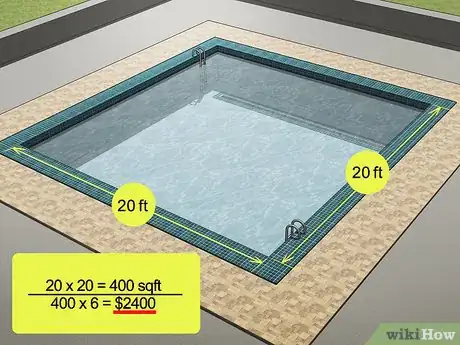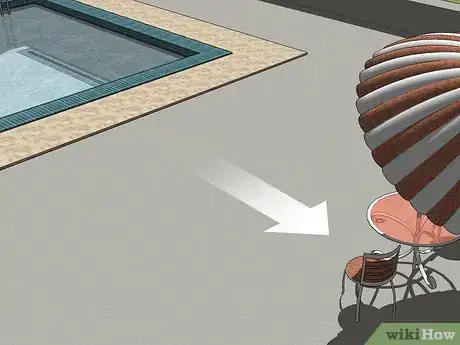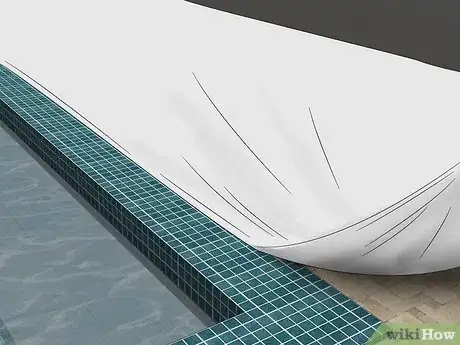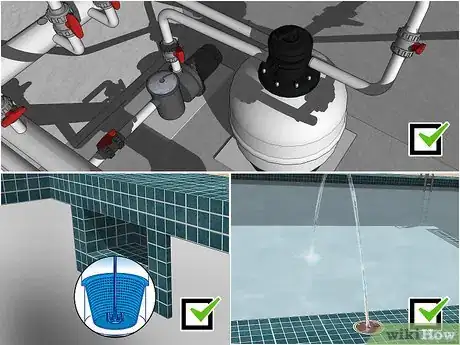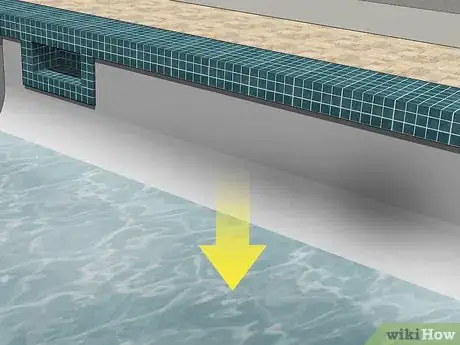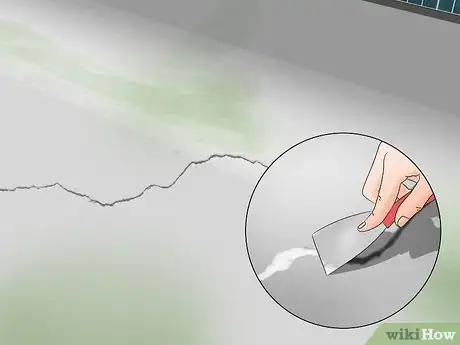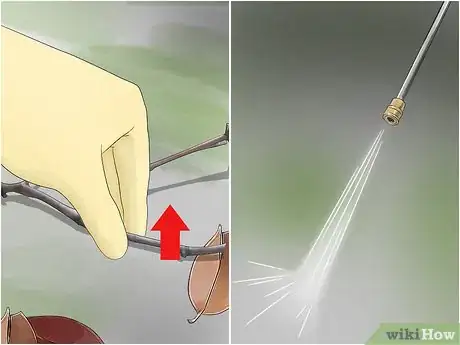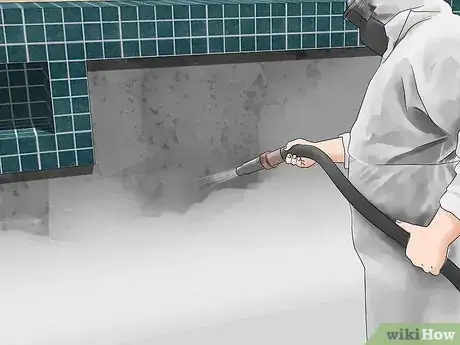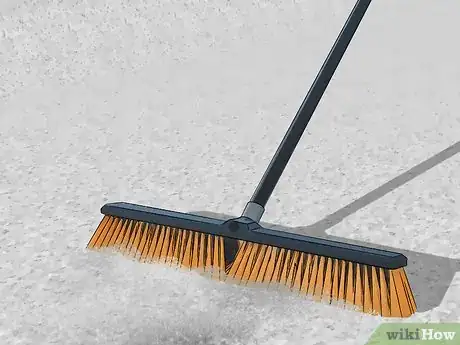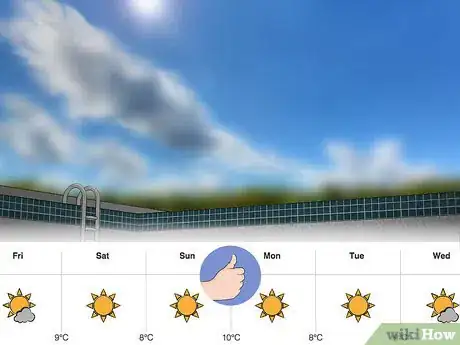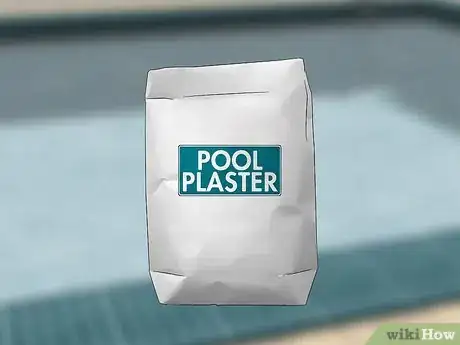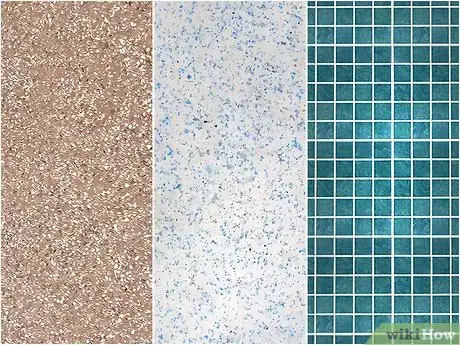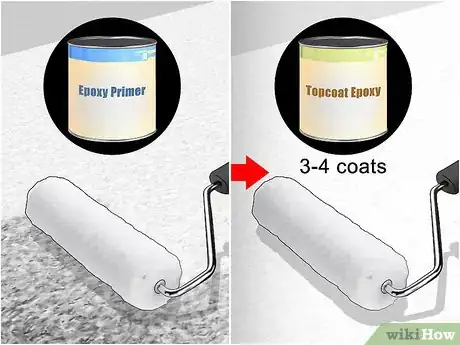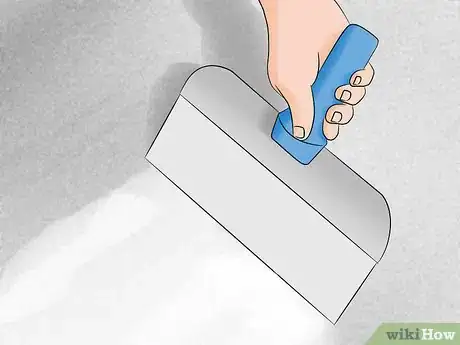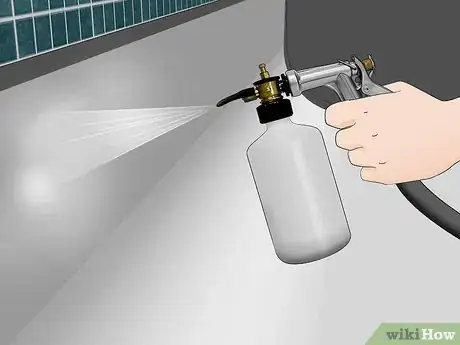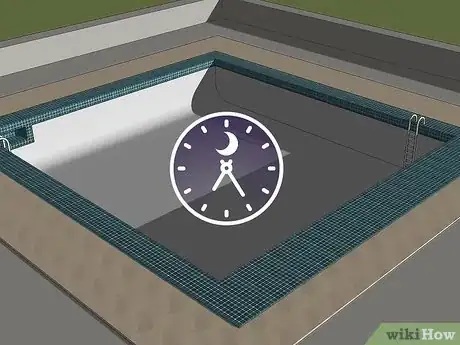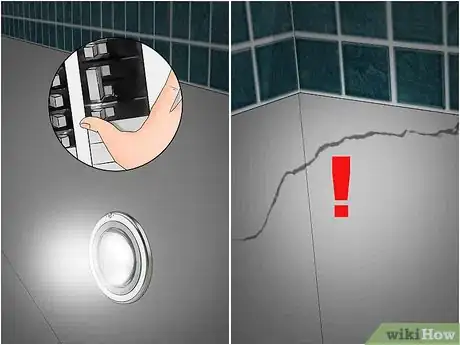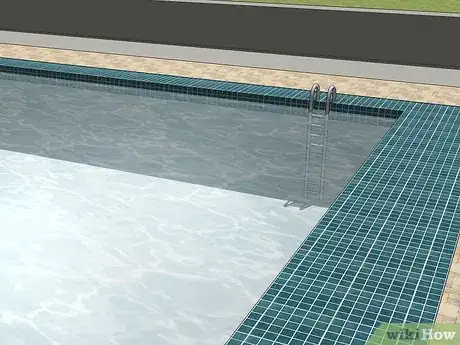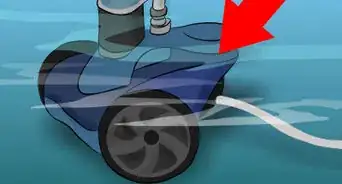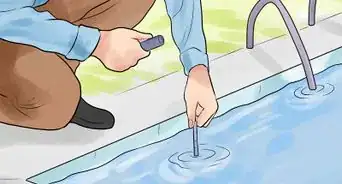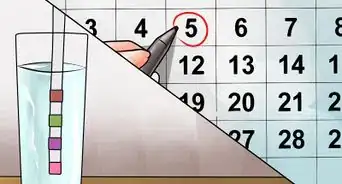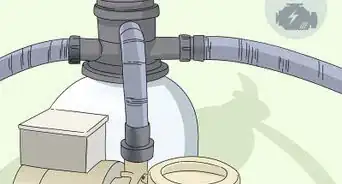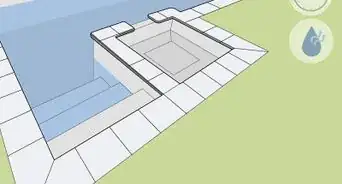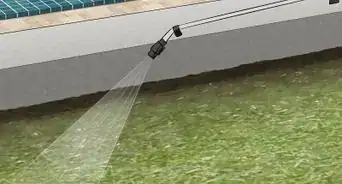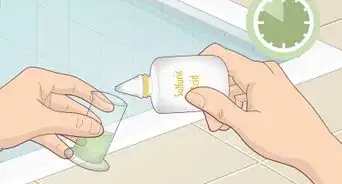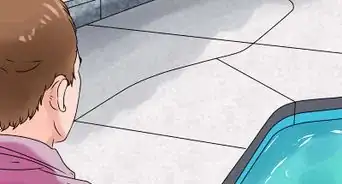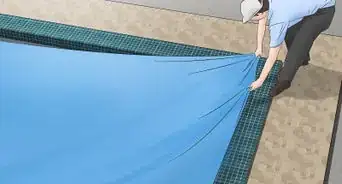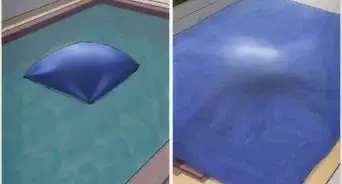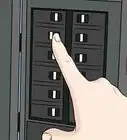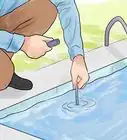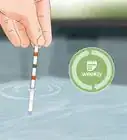This article was co-authored by Rob Litman. Rob Litman is a Landscaper, General Contractor, and the CEO of Vitoli Inc., a landscaping, hardscaping, ecoscaping, and swimming pool design company in Los Angeles, California. With over 20 years of experience in construction, Rob specializes in energy-efficient and drought-tolerant landscaping. He holds General Building Contractor (Class B) and Registered Pool/Spa Contractor Licenses. In 2007, Rob won House of the Year in Gardena, California.
There are 15 references cited in this article, which can be found at the bottom of the page.
This article has been viewed 58,853 times.
Over time, exposure to the elements and various chemicals can eat away at a pool’s surface, leading to costly repairs. That’s why for most pool owners, it will be necessary to have their pools refinished every 8-10 years. You'll know it's time to resurface your pool when you see the plaster peeling away to the point that the cement underneath is showing. Resurfacing is an ambitious project, but it’s not one that you can’t tackle yourself if you have the time and know-how.
Steps
Preparing Your Pool Area
-
1Estimate your budget for the project. Before you can begin refinishing your pool, you’ll need to be sure that you can afford it. The average resurfacing project costs around $6 per square foot. Add up the total square footage of your pool and multiply it by 6 to get a ballpark estimate of how much you can expect to spend.[1]
- Certain longer-lasting surfacing materials like fiberglass or tile may add considerably to the overall cost of your project.[2]
- This estimate only covers the costs of basic materials, and may not account for extensive repair work or additional equipment that may be necessary to see the project through.
-
2Clear the surrounding area. Start by removing all patio furniture, electronics and other accessories from the pool area and storing them in a separate location. Stripping a swimming pool tends to spread lots of dust and debris. If you’re not careful, you could ruin more delicate items and leave yourself with a big mess to clean up.Advertisement
-
3Protect the area around the pool. Tape a few tarps or weather-resistant drop cloths down around the outer perimeter of the pool. Be sure to also throw one over any nearby furniture or appliances you can’t find storage space for.
-
4Confirm that the pool’s other features are functional. While the pool is still full, check to make sure the jets, filters, skimmers and lights are all working the way they’re supposed to. If there’s a problem with any of the pool’s equipment, you’ll be able to address it before the actual resurfacing gets underway.
- Take a close look at each of these areas and perform a few quick tests, like turning the underwater lights off and on and running your hand over the jets to feel whether they’re circulating water correctly.
- Keep an eye out for debris and other large obstructions that may be clogging the skimmers.
Draining and Stripping the Pool
-
1Drain the pool. Access your pool’s central pump system and switch it over to the “drain” or “backwash” setting. If for some reason you can’t do this from the main pump, you can also use a submersible pump to cycle the water out of the pool. Resurfacing cannot begin until the pool has been emptied completely.[3]
- Direct the runoff water somewhere where it won’t cause flooding, oversaturation or similar complications.
- Depending on the size of your pool, the draining stage may take several hours. Be sure to budget your time accordingly.
-
2Patch or repair serious damage. Go around the inside of the pool and scan for cracks, crumbling, blistering and other deterioration. These types of marks may indicate a more immediate issue with the pool’s plumbing or in-ground foundation. Don’t worry too much about general wear—resurfacing the pool will deal with minor cosmetic imperfections.
- A slow leak, for instance, could be the result of a deep crack in the bottom of the pool.
- When faced with lots of small damaged areas, it’s a good idea to go ahead and have your entire pool resurfaced, rather than attempting to rely on a quick patch alone. With time, other areas will begin to deteriorate and you’ll be right back where you started.[4]
- Should you happen to come across areas that look like they could present a problem, call a pool contracting specialist and have them come out to survey the extent of the damage.
-
3Clean the pool’s surface. Collect larger bits of debris like twigs, leaves and stones by hand, then pressure wash the inside of the pool to remove algae, stubborn stains and chemical and mineral deposits. A thorough cleaning is a must, even if you’re planning on resurfacing the entire pool.[5]
- The smallest traces of dirt or debris could potentially ruin your new surface material’s ability to set up correctly.
-
4Strip the existing materials. Plaster, fiberglass and composite finishes will have to be sandblasted or otherwise chiseled away to the underlying concrete in order to provide a better hold for the new material. Focus on one small area of the pool's surface at a time and move the nozzle of the sandblaster up and down to eat away at the liner. The stripping process will typically take 1-3 days, depending on the size of your pool and crew.[6]
- Wear the proper safety equipment—at the minimum, you’ll need a respirator or filtration mask, eye protection and a pair rugged work gloves.
- It can cost thousands of dollars to have a pool sandblasted professionally and hundreds to rent and operate a sandblaster yourself. Keep this in mind when coming up with your projected budget.[7]
-
5Dispose of the stripped materials. Use a wet/dry vacuum to suction up as much dust and debris as you can from in and around the pool area. Then, gather up your tarps or drop cloths and transport them somewhere where they can be sprayed off with a hose without making a mess.
- Cleanup can be very involved, and may require you to tack on an extra day or two to your project timeline.
- One of the perks of having your pool professionally resurfaced is that the contractor's team is responsible for getting your pool area put back in order.
Applying Various Finishes
-
1Schedule your project for the right time. Settle on a stretch where weather conditions will be most favorable for the materials you're working with. For instance, epoxy paints, fiberglass and materials like concrete and grouting set fastest in warm, dry weather, while little rain or humidity may not hurt fresh plaster, since the moisture in the atmosphere will keep it from drying too quickly.[8]
- Stay on top of your local forecast in the days before you begin resurfacing. It's possible for precipitation and extremes in temperature to interfere with the resurfaced pool’s dry time.[9]
- Similarly, gusty winds could blow dirt, leaves and other debris into wet paint or plaster before it's had time to dry.
-
2Choose a basic surfacing material. Nowadays, pool owners have a wide range of options available to pick from. For most small or standard pools, a simple plaster or fiberglass finish is a practical choice, as they're readily available and aren't overly difficult to install. They also tend to be the most affordable, which is a plus if you happen to be working under budget constraints.[10]
- Plaster doesn’t tend to last as long as synthetic or composite materials, so it will likely need to be replaced more frequently.[11]
-
3Go with a long-lasting finish. High-end pools cut a very impressive appearance when surfaced with materials like pebble concrete, quartz or ceramic tile. These types of materials offer a durable lining that resists algae, stains and chemical-related damage.[12]
- Read up on the benefits and drawbacks of different surfacing materials and take them into consideration when making your final selection.
-
4Brush on an epoxy paint. Roll on a pool specific epoxy primer from one end of the pool to the other. Once the primer is dry to the touch, roll on 3-4 coats of topcoat epoxy, using a handheld brush to touch up hard-to-reach spot. Sand the epoxy lightly between coats to ensure that the subsequent coat will stick properly.[13]
- Each coat will require 2-3 hours of drying time, but may take longer depending on the climate in your area.
- Use only pool specific types of epoxy. These are available at most home improvement centers and pool and spa stores, and often come in kits that include detailed instructions for DIY application.
- More and more pool owners are going with epoxy finishes because they’re cheap, durable, offer a strong seal and are easy to reapply later.[14]
-
5Spread fresh plaster by hand. Combine the dry plaster components with water in a large drum or tub until it reaches a thick, smooth consistency. Spread the plaster over the entire surface of the pool with a trowel, being careful to avoid gaps or inconsistencies in thickness. For the most durable and attractive surface, aim for a finish that’s between ¼” and ⅜” (.64-.95cm)[15]
- When mixing your own plaster, it’s best to use a ratio of two parts fine white silica sand to one part extra fine cement powder.[16]
- A power trowel may come in handy for smoothing pool floors with large surface areas.
-
6Apply fiberglass in multiple coats. Starting with a thin seal coat, user a paint roller or sprayer to cover the walls and floor of the pool with the flexible liquid. Spray a coat of resin over the top, then roll and sand the layers to smooth them before leaving them to cure. The completed finish should be roughly 3/16” thick.[17]
- Fiberglass clings to whatever it touches, so be sure to wear a change of old clothes that you don’t mind ruining.
-
7Allow the new surface to dry. No matter what material you decide on, it will need plenty of time to set up once it’s in place. A basic epoxy paint will usually dry in a matter of hours or overnight, while more temperamental materials like plaster and fiberglass may require days to cure completely.[18]
- Plaster cures best underwater, so there’s no need to hold off on refilling your pool once the initial set is complete.[19]
-
8Inspect the pool inside and out. Double check that the plumbing fixtures and lighting elements are properly sealed and functional before you begin adding water to the pool. This will also be your last chance to take care of any last minute details like sanding or touching up bare spots you may have missed.
- Never fill a swimming pool with visible holes, cracks or exposed concrete. This can easily lead to leaks, which are very expensive to repair and will force you to drain the pool all over again.
- Bad wiring in underwater lights could become a safety hazard when swimming.[20]
-
9Refill the pool. Once the new surface materials have dried, the only thing left to do is fill the pool up with fresh water. Don’t forget to add the right proportions of chlorine or salt to balance the water’s pH levels and keep unwanted flora and fauna from moving in. You’ll now be able to enjoy a dip in your newly renovated pool![21]
- A water truck or hydrant will allow you to refill your pool much faster than a standard garden hose.[22]
Expert Q&A
Did you know you can get expert answers for this article?
Unlock expert answers by supporting wikiHow
-
QuestionDo I need to resurface my pool if I see creases in the plaster?
 Rob LitmanRob Litman is a Landscaper, General Contractor, and the CEO of Vitoli Inc., a landscaping, hardscaping, ecoscaping, and swimming pool design company in Los Angeles, California. With over 20 years of experience in construction, Rob specializes in energy-efficient and drought-tolerant landscaping. He holds General Building Contractor (Class B) and Registered Pool/Spa Contractor Licenses. In 2007, Rob won House of the Year in Gardena, California.
Rob LitmanRob Litman is a Landscaper, General Contractor, and the CEO of Vitoli Inc., a landscaping, hardscaping, ecoscaping, and swimming pool design company in Los Angeles, California. With over 20 years of experience in construction, Rob specializes in energy-efficient and drought-tolerant landscaping. He holds General Building Contractor (Class B) and Registered Pool/Spa Contractor Licenses. In 2007, Rob won House of the Year in Gardena, California.
Licensed Landscaper & General Contractor
-
QuestionHow do I know when it's time to resurface my pool?
 Rob LitmanRob Litman is a Landscaper, General Contractor, and the CEO of Vitoli Inc., a landscaping, hardscaping, ecoscaping, and swimming pool design company in Los Angeles, California. With over 20 years of experience in construction, Rob specializes in energy-efficient and drought-tolerant landscaping. He holds General Building Contractor (Class B) and Registered Pool/Spa Contractor Licenses. In 2007, Rob won House of the Year in Gardena, California.
Rob LitmanRob Litman is a Landscaper, General Contractor, and the CEO of Vitoli Inc., a landscaping, hardscaping, ecoscaping, and swimming pool design company in Los Angeles, California. With over 20 years of experience in construction, Rob specializes in energy-efficient and drought-tolerant landscaping. He holds General Building Contractor (Class B) and Registered Pool/Spa Contractor Licenses. In 2007, Rob won House of the Year in Gardena, California.
Licensed Landscaper & General Contractor
-
QuestionShould I resurface my pool early just to be safe?
 Rob LitmanRob Litman is a Landscaper, General Contractor, and the CEO of Vitoli Inc., a landscaping, hardscaping, ecoscaping, and swimming pool design company in Los Angeles, California. With over 20 years of experience in construction, Rob specializes in energy-efficient and drought-tolerant landscaping. He holds General Building Contractor (Class B) and Registered Pool/Spa Contractor Licenses. In 2007, Rob won House of the Year in Gardena, California.
Rob LitmanRob Litman is a Landscaper, General Contractor, and the CEO of Vitoli Inc., a landscaping, hardscaping, ecoscaping, and swimming pool design company in Los Angeles, California. With over 20 years of experience in construction, Rob specializes in energy-efficient and drought-tolerant landscaping. He holds General Building Contractor (Class B) and Registered Pool/Spa Contractor Licenses. In 2007, Rob won House of the Year in Gardena, California.
Licensed Landscaper & General Contractor Replastering your pool before concrete is showing is just an aesthetic choice. However, it's normally a good idea to wait, because once you go in and chip the plaster, there's a chance the return lines could break and then you'll have to redo the whole pool. It's better not to rush into that before you need to.
Replastering your pool before concrete is showing is just an aesthetic choice. However, it's normally a good idea to wait, because once you go in and chip the plaster, there's a chance the return lines could break and then you'll have to redo the whole pool. It's better not to rush into that before you need to.
Warnings
- Making a mistake while attempting to resurface your pool on your own could end up costing you thousands of dollars. It bears repeating that hiring a qualified pool contractor will be the way to go for most pool owners.⧼thumbs_response⧽
Things You'll Need
- Submersible pool pump
- Sandblaster
- Pressure washer
- Chemical solvent (for synthetic materials)
- Pool plaster
- Pool specific epoxy
- Fiberglass liquid
- Paint roller and paintbrush
- Hand trowel
- Chisel
- Spray gun
- Rubber roller
- Electric sander
- Drop cloths or tarps
- Plastic sheeting
- Painter's tape
- Respirator or ventilated facemask
- Thick work gloves
- Eye protection
References
- ↑ http://www.improvenet.com/a/how-to-resurface-a-swimming-pool
- ↑ https://www.angieslist.com/articles/how-much-does-it-cost-resurface-swimming-pool.htm
- ↑ https://www.youtube.com/watch?v=Y8qMgAKTzcY
- ↑ https://www.angieslist.com/articles/how-much-does-it-cost-resurface-swimming-pool.htm
- ↑ http://www.improvenet.com/a/how-to-resurface-a-swimming-pool
- ↑ http://www.swimmingpoolsteve.com/pages/pool-paint.html
- ↑ https://www.hunker.com/13403080/how-to-rent-a-sand-blaster
- ↑ http://articles.bluehaven.com/the-awful-truth-weather-and-pool-construction-delays
- ↑ http://blog.poolcenter.com/article.aspx?articleid=6146
- ↑ https://www.poolpricer.com/pool-resurfacing-options-cost-complications/
- ↑ https://www.angieslist.com/articles/how-much-does-it-cost-resurface-swimming-pool.htm
- ↑ https://www.poolpricer.com/pool-resurfacing-options-cost-complications/
- ↑ http://www.improvenet.com/a/how-to-resurface-a-swimming-pool
- ↑ https://www.bobvila.com/articles/pool-resurfacing/#.WYtgo1GGPIU
- ↑ http://www.truetex.com/pool.htm
- ↑ http://www.swimmingpoolsteve.com/pages/concrete.html
- ↑ https://www.youtube.com/watch?v=tO4Ua0n2EJA
- ↑ http://www.improvenet.com/a/how-to-resurface-a-swimming-pool
- ↑ http://blog.poolcenter.com/article.aspx?articleid=6175
- ↑ http://www.nbcnews.com/news/us-news/swimming-pool-safety-electrocutions-raise-alarm-summer-n112521
- ↑ http://www.improvenet.com/a/how-to-resurface-a-swimming-pool
- ↑ https://www.poolpricer.com/cost-to-fill-pool-with-water/
